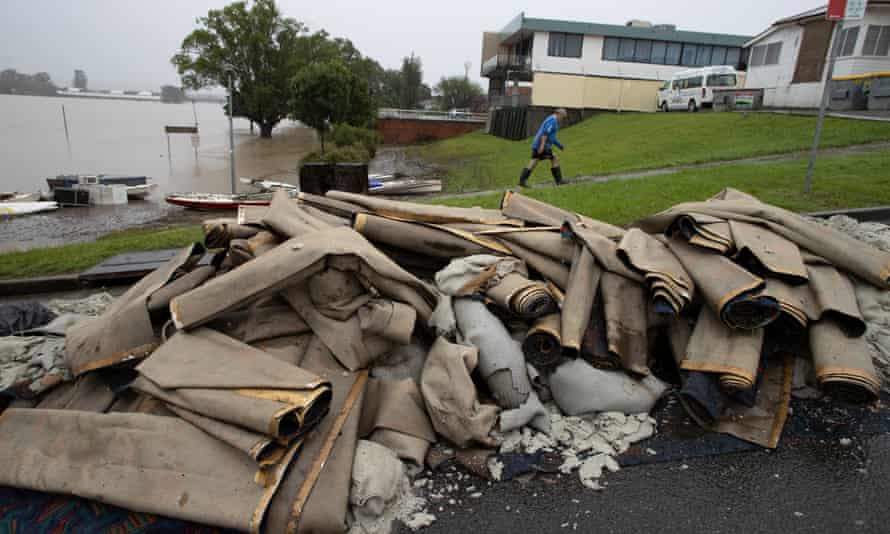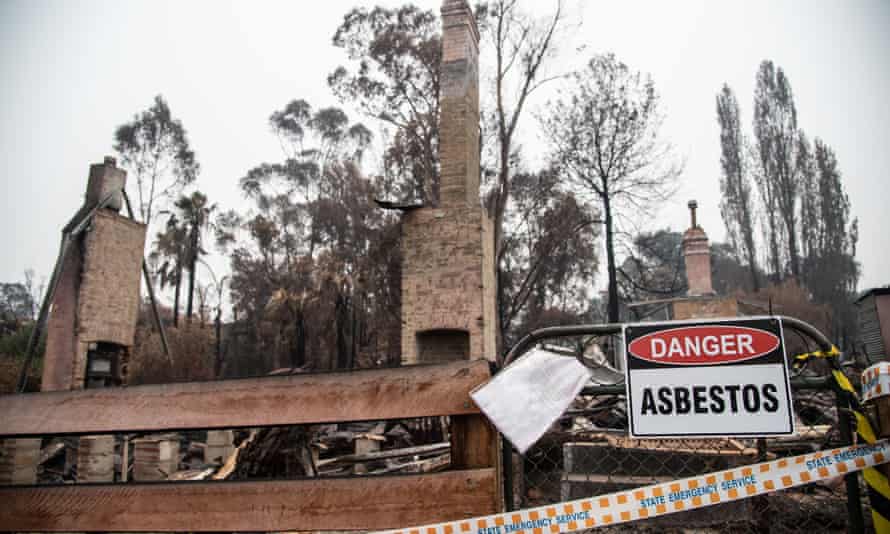Fire and flood: ‘Whole areas of Australia will be uninsurable’ | Australia news
It was the Monday after the Warragamba Dam overflowed that Dr Kim Loo began to understand the scale of what was happening. A patient had called into her clinic in Riverston in Sydney’s west to cancel an appointment to pick up a prescription as the bridge into town was out.
Loo, chair of the New South Wales chapter of Doctors for the Environment, has lived and worked in Riverston much of her life. Over the years she has watched the market gardens once run by Maltese families out on the flood plain give way to new housing as developers have paved over the open ground.
Now it was happening again. First came fire, now came the flood.
“This is not just the floods, it’s the smoke and the heat and Covid and everything else,” she says. “Every single disaster, we seem to be on the pointy end of it. We already hit two degrees above average during the black summer. We had the hailstorms in eastern Sydney. Now, with this, I imagine whole areas will be uninsurable.”
After the events of the past two years, that question – what is going to happen with insurance? – is proving increasingly significant for entire communities and the insurance industry as they confront a climate-shocked future.
Mark Leplastrier, an atmospheric scientist who heads up Insurance Australia Group’s (IAG) natural perils unit, says this specific flooding event was no surprise. As Australia moves between El Niño and La Niña cycles, significant weather events tend to cluster. The role of climate change, Leplastrier says, is to make weather events a little worse with each passing cycle.
“Every disaster, every new major event – a cyclone, a flood, a bushfire, a hailstorm – provides a chance to test your underlying assumptions,” Leplastrier says. “The main thing is, with climate change in the background of a natural variability cycle, if you have the same event coming back, and you have more warming, you have extra rainfall or intensity associated with that.
“So that’s the question: how exactly is it going to play out?”

The industry calls these events “natural perils” and ranks them according to severity. Flood, fire and hailstorms are “secondary perils”, events that can sometimes last only a few minutes or hours but rack up millions of dollars in damage. “Primary perils” are major events such as earthquakes and cyclones.
While a flood may be costly thanks to the expensive recovery process that follows, the nightmare scenario is for a cyclone to slam into a heavily populated area in a region such as south-east Queensland. While the chance of this happening would have once been considered zero, climate change means the possibility can no longer be totally discounted.
And the cost of these events is mounting. Though it is too early to know the full cost of the current one-in-100-year flooding event, the Insurance Council of Australia has already declared a catastrophe for NSW and south-east Queensland. With more than 17,000 insurance claims filed as of Wednesday morning, an early industry estimate puts the total estimated damage across two states at $254.2m.
By contrast, the cost to just four insurers – Allianz, QBE Insurance, Suncorp and IAG – in the wake of the black summer bushfires was $721m. Meanwhile the industry as a whole lost $5.3bn paying out for damage caused by bushfire, flood and hailstorms during the first quarter of 2020.
The scale of damage and the size of the loss incurred by IAG and Suncorp alone was so great the companies burned through their catastrophe allowances and had to draw on their reinsurance contracts – the insurance for insurers – prompting the world’s largest reinsurer, Swiss Re, to publicly lash the companies for consistently failing to predict the cost of natural disasters.
Viewed over time, the impact is stark. Graphs published by the Australian Prudential Regulatory Authority (Apra) recording the financial profitability of the insurance industry were dominated by gentle curves before 2015. Beyond that point, the lines become jagged and the graphs saw-toothed.
The longer this goes on, the more the industry has been passing the cost on to the consumer.
Dr Chloe Lucas from the University of Tasmania studies the social impacts of climate change and says prices are rising as the insurers change the way they do business. Under the old “community model”, the price of coverage would be calculated at the level of a neighbourhood, suburb, town or region. This meant those who were a little more exposed to flood or fire would have their coverage subsidised by those who weren’t and everyone was better off.
Thanks to big data, insurance companies are now able to drill down to the level of a single household and price them accordingly, driving premiums up for some and lowering them for others.
“The industry has moved as best-practice to individualised pricing, as it gives a signal about risk,” Lucas says. “People will become more aware about climate risk and will be more likely to move, but in reality people can’t afford to move their house and they get stuck there.
“That means people will have to pay ridiculous prices or have no cover at all.”

The result has been a growing inequity between those who can afford to pay, and those who can’t. The growing divide was so concerning to Apra, its executive board member Geoff Summerhayes gave a stark warning in a speech last October.
“Apra’s biggest concern when it comes to the impact of climate-related risks on insurance is therefore not the prospect of an insurer becoming insolvent, it’s the possibility that general insurance might become unaffordable or even unavailable in parts of Australia,” he said.
“Without access to appropriate general insurance, households and businesses would be less confident to invest or take financial risks in vulnerable parts of the country. Access to credit may be reduced, while credit risk for existing loans would rise. Communities would take longer to recover in the aftermath of disasters, and more of the financial burden of recovery would fall on governments and, by extension, taxpayers.
“For these reasons, countries with larger insurance protection gaps typically suffer more severe economic consequences after disasters, such as reduced productivity and higher debt levels.”
In some parts of Australia, what Summerhayes was describing was already a fact of life. Across the cyclone-prone north, the cost of home insurance has increased by 178% since 2007, while the price for combined home and contents insurance has grown by 122%.
These comments have since been read as a rebuke to the attitude taken by some in industry that as climate crisis gets worse the simple solution is to pass the risk – and the cost – on to the consumer. In one example, Nicholas Scofield, the chief corporate affairs officer for Allianz Australia, appeared before a hearing of the Senate’s bushfire inquiry in July 2020. The committee chair, Labor senator Tim Ayres, asked him whether climate change represented an “existential threat for the industry in some parts of Australia”.
“I don’t think it’s an issue in that sense, simply because we get to reprice every customer every year,’’ Scofield said. “We get to look at the premiums we need to charge and the amount of reinsurance we need to purchase to make sure our balance sheet and our shareholders are protected.

“The customers bear it at the end of the day. As I said before, it’s been a particular concern of Allianz’s for some time that we already see natural-peril risks that result in premiums that customers can’t afford.”
At the time, the moment was read as a frank statement of intent from the industry. While it had called for more mitigation work to be done to adapt to the effects of climate change, and for tax reform to lower the cost of premiums, within Australia there have been no public calls for the government to act to bring downward pressure on emissions.
In fact, during that hearing, the industry largely accepted that a world 2C hotter on average was now locked in, a position outlined in IAG’s report on climate change.
“A 2C target is therefore unlikely to be achieved and will therefore significantly increase the risk for catastrophic events, even compared to 1.5C warming,” the report said.
Unless the underlying cause can be addressed, extreme events will continue to batter regional and working-class people.
“If you look at a map of New South Wales, there’s about 14 local government areas that have flooded that also had these bushfires,” says Financial Counselling Australia’s national co-ordinator for bushfire recovery, Peter Gartlan. “At the moment all the risk is put on the consumers. The second issue is that insurance premiums are going to increase – they’re increasing already – and the government have got to get involved in that issue.
“Otherwise, if we’re going to have these disasters occurring in response to climate change, then the cost is being shifted across to the individual.”
Gartlan has been collecting data from the 7,000 people who have sought help from financial counsellors after the bushfires. Most need help with writing grant applications, managing pre-existing debts, obtaining mental support and, crucially, a lack of insurance.
Gartlan tells of a not-for-profit organisation assisting people in the Snowy and Bega valleys, among other places. “They gave out 600 lots of emergency relief, on average about $2,000,’’ he says. “They also did a straw poll: do you have insurance? Are you fully covered?
“So 50% of those 600 people had no insurance. About 25% were underinsured, and the other 25% believed they had enough insurance.”
Because most insurance contracts today are for “sum insured”, Gartlan says many learn in the wake of a disaster that they have incorrectly estimated the cost of rebuilding their home or business and so are forced to take out new loans, or move away entirely.
“It’s apocalyptic, really,” Gartlan says. “And these events have been one after the other. They haven’t been spaced out. I don’t know how people are going to react.”



